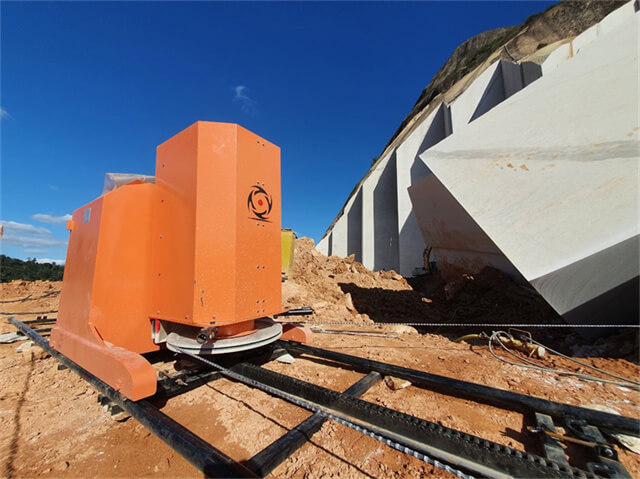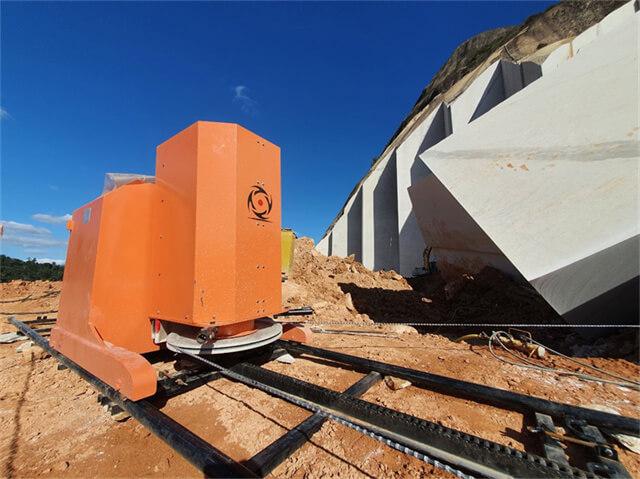Author:Huada Quarrying Machine FROM:Stone quarry machine manufacturer TIME:2024-11-20
Wire saw cutting machines have revolutionized the stone industry, providing a precise and efficient means of cutting various types of stone. These machines utilize a thin wire with diamond segments attached, allowing for clean cuts without the excessive waste typically seen in traditional cutting methods. This article explores the types of stone that can be effectively cut using wire saw technology, highlighting their properties, applications, and advantages.
Granite is one of the hardest and most durable natural stones, making it a popular choice for countertops, flooring, and monuments. Wire saws excel at cutting granite due to their ability to make intricate cuts without causing chipping or cracking. The precision of wire saws allows for the production of complex shapes and designs, which are highly sought after in architectural applications. Additionally, the reduced kerf width minimizes material loss, making granite more cost-effective to work with.
Marble is renowned for its aesthetic appeal, often used in sculptures, tiles, and decorative elements. The wire saw cutting method is particularly advantageous for marble because it produces smooth edges and minimizes the risk of damage during the cutting process. Unlike traditional saws that may cause rough edges or fractures, wire saws maintain the integrity of the marble’s surface, ensuring high-quality finishes. The versatility of wire saws also allows for different thicknesses and patterns to be achieved, catering to various design needs.

Limestone is a softer stone that is commonly used in construction and landscaping. While it is easier to cut compared to harder stones like granite and marble, wire saws provide a controlled cutting experience. This is particularly important when working with limestone, as it can be prone to cracking if not handled carefully. Wire saws produce cleaner cuts, reducing the incidence of waste and allowing for more accurate installations, whether in building facades or decorative features.
Quartzite, known for its strength and durability, is increasingly being used in high-end applications such as countertops and flooring. The density of quartzite presents challenges when cutting, but wire saws meet these challenges effectively. They allow for precise cuts that enhance the natural beauty of the stone while maintaining structural integrity. Moreover, the use of wire saws helps in achieving thinner slabs, which are desirable for modern design aesthetics. This technique also reduces the risk of chips and cracks that can occur with traditional cutting methods.

Soapstone is a soft metamorphic rock that has become popular in kitchen countertops and stoves due to its heat resistance and ease of maintenance. Wire saws are ideally suited for soapstone because they handle the material's softness without causing excessive wear on the equipment. Furthermore, the precision offered by wire saw cutting ensures that detailed edges and curves can be achieved, enhancing the overall appearance of the finished product. This method also facilitates the crafting of intricate designs, making soapstone a versatile choice for artistic applications.
Basalt, a volcanic rock, is often used in landscaping and construction due to its durability and unique texture. Cutting basalt with traditional methods can be challenging due to its hardness, but wire saws can navigate these difficulties effectively. The consistent tension of the wire allows for smoother cuts, reducing the likelihood of fracturing the stone. Wire saw technology also enables the creation of various shapes and sizes, making it an excellent choice for both functional and decorative applications.
Sandstone is a sedimentary rock characterized by its variable composition and color. It is commonly used in building materials and outdoor landscaping. Wire saws are particularly beneficial for cutting sandstone, as they minimize the risk of erosion and maintain the stone’s natural texture. The ability to produce intricate details without damaging the stone makes wire saws an essential tool for artisans and builders alike. This method also allows for the efficient use of raw materials, resulting in less waste during the cutting process.

Travertine is another popular stone in the construction industry, valued for its unique appearance and thermal properties. When cutting travertine, maintaining the stone’s porous structure is crucial. Wire saws provide the necessary precision to achieve this, ensuring that cuts are clean and do not compromise the material's integrity. The controlled nature of wire saw cutting means that travertine can be shaped into various forms, making it ideal for both indoor and outdoor applications.
Wire saw cutting machines are an invaluable asset in the stone industry, capable of handling a diverse range of stones, including granite, marble, limestone, quartzite, soapstone, basalt, sandstone, and travertine. Each type of stone presents unique challenges, but the precision and efficiency of wire saw technology address these effectively. As the demand for high-quality stone products continues to grow, wire saws will remain at the forefront of stone cutting, enabling manufacturers to deliver exceptional results while minimizing waste and optimizing costs. Embracing this technology not only enhances production capabilities but also supports the evolving needs of architects, designers, and builders worldwide.